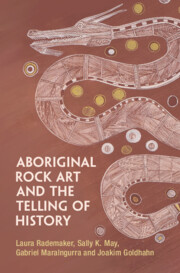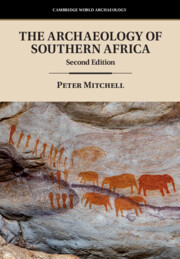Refine search
Actions for selected content:
126 results
Deleuze and the ontology of prehistoric rock art
-
- Journal:
- Archaeological Dialogues , First View
- Published online by Cambridge University Press:
- 01 August 2025, pp. 1-20
-
- Article
-
- You have access
- Open access
- HTML
- Export citation
An early ruler etched in stone? A rock art panel from the west bank of Aswan (Egypt)
-
- Article
-
- You have access
- HTML
- Export citation
Geological dating of the earliest Minusinsk Depression rock art, the Maydashy site, Southern Siberia
-
- Journal:
- Quaternary Research / Volume 126 / July 2025
- Published online by Cambridge University Press:
- 29 April 2025, pp. 71-84
-
- Article
- Export citation
Rising up: digital traces and performative Indigenous culture in Australian rock art
-
- Article
-
- You have access
- Open access
- HTML
- Export citation

Aboriginal Rock Art and the Telling of History
-
- Published online:
- 12 November 2024
- Print publication:
- 05 December 2024
Giving rock art new life: combining past images, identity and contemporary art
-
- Article
-
- You have access
- HTML
- Export citation
Paisajes agrícolas miniaturas de tiempos prehispánicos tardíos en las tierras altas de Arica (Andes centro sur)
-
- Journal:
- Latin American Antiquity , First View
- Published online by Cambridge University Press:
- 29 August 2024, pp. 1-8
-
- Article
- Export citation
8 - Hunting, Gathering, Intensifying: Forager Histories in the Holocene before 2000bp
-
- Book:
- The Archaeology of Southern Africa
- Published online:
- 15 May 2024
- Print publication:
- 06 June 2024, pp 189-230
-
- Chapter
- Export citation
Implications of Rock Art Aesthetics in Olmec Sculpture
-
- Journal:
- Latin American Antiquity / Volume 35 / Issue 2 / June 2024
- Published online by Cambridge University Press:
- 29 August 2024, pp. 521-541
- Print publication:
- June 2024
-
- Article
- Export citation
Monumental snake engravings of the Orinoco River
-
- Article
-
- You have access
- Open access
- HTML
- Export citation

The Archaeology of Southern Africa
-
- Published online:
- 15 May 2024
- Print publication:
- 06 June 2024
Arte rupestre del primer y segundo milenio dC en las sierras de Velasco y de La Punta (La Rioja, Argentina)
-
- Journal:
- Latin American Antiquity , First View
- Published online by Cambridge University Press:
- 02 April 2024, pp. 1-23
-
- Article
- Export citation
2 - Spanish Jamaica, 1509–1655
-
- Book:
- A Concise History of Jamaica
- Published online:
- 23 November 2023
- Print publication:
- 14 December 2023, pp 44-76
-
- Chapter
- Export citation
1 - The Taino
-
- Book:
- A Concise History of Jamaica
- Published online:
- 23 November 2023
- Print publication:
- 14 December 2023, pp 10-43
-
- Chapter
- Export citation
Mezclas pigmentarias, recetas pictóricas e historias: Una aproximación fisicoquímica a las prácticas sociales de pintado en el cerro de Oyola (Catamarca, Argentina)
-
- Journal:
- Latin American Antiquity / Volume 35 / Issue 4 / December 2024
- Published online by Cambridge University Press:
- 15 November 2023, pp. 983-1002
- Print publication:
- December 2024
-
- Article
- Export citation
Long Distance Connections Within Britain and Ireland: the Evidence of Insular Rock Art
-
- Journal:
- Proceedings of the Prehistoric Society / Volume 89 / December 2023
- Published online by Cambridge University Press:
- 23 October 2023, pp. 249-271
- Print publication:
- December 2023
-
- Article
-
- You have access
- Open access
- HTML
- Export citation
From simple row of dots to the rain god calendar: Interpretation of the pecked cross petroglyph from the Late Postclassic Tetzcotzinco
-
- Journal:
- Ancient Mesoamerica / Volume 35 / Issue 2 / Summer 2024
- Published online by Cambridge University Press:
- 25 September 2023, pp. 430-450
- Print publication:
- Summer 2024
-
- Article
-
- You have access
- Open access
- HTML
- Export citation
Cova Dones: a major Palaeolithic cave art site in eastern Iberia
-
- Article
-
- You have access
- Open access
- HTML
- Export citation
Al-Muqrinat cave in the countryside of Cyrene: revisiting the prehistoric engravings
-
- Journal:
- Libyan Studies / Volume 53 / November 2022
- Published online by Cambridge University Press:
- 24 October 2022, pp. 11-15
- Print publication:
- November 2022
-
- Article
-
- You have access
- HTML
- Export citation
